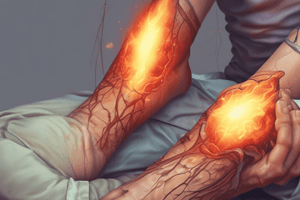Podcast
Questions and Answers
What is the extent of tissue damage in a superficial, partial-thickness burn?
What is the extent of tissue damage in a superficial, partial-thickness burn?
- Both epidermis and dermis are injured
- Accessory structures are also injured
- Only dermis is injured
- Only epidermis is injured (correct)
What is the typical recovery outcome for deep, partial-thickness burns?
What is the typical recovery outcome for deep, partial-thickness burns?
- Never heals
- Always requires skin grafts
- Usually results in scarring
- Usually recovers completely, no scarring (correct)
What is the source of stem cells that help regenerate skin in deep, partial-thickness burns?
What is the source of stem cells that help regenerate skin in deep, partial-thickness burns?
- Hair follicles and glands (correct)
- Nerve endings
- Bone marrow
- Muscle tissue
What is the purpose of the Rule of Nines?
What is the purpose of the Rule of Nines?
What is the characteristic of a full-thickness burn?
What is the characteristic of a full-thickness burn?
How do full-thickness burns typically heal?
How do full-thickness burns typically heal?
What is the result of prolonged exposure to heat, flames, or hot liquids?
What is the result of prolonged exposure to heat, flames, or hot liquids?
What is the typical healing time for superficial, partial-thickness burns?
What is the typical healing time for superficial, partial-thickness burns?
What is the advantage of stem cells in hair follicles and glands in deep, partial-thickness burns?
What is the advantage of stem cells in hair follicles and glands in deep, partial-thickness burns?
What is the significance of blistering in deep, partial-thickness burns?
What is the significance of blistering in deep, partial-thickness burns?
Flashcards are hidden until you start studying
Study Notes
Layers of the Skin
- The skin and its accessory structures make up the integumentary system
- The skin is the largest organ by weight, composed of several tissue types, and is also called the cutaneous membrane
- The skin has two main layers: epithelial tissue overlying connective tissue
- The epidermis is the outer layer, composed of stratified squamous epithelium
- The dermis is the inner layer, thicker than the epidermis, and is composed of connective tissue with collagenous and elastic fibers, muscle, blood, and nervous tissue
- The subcutaneous layer (hypodermis) is beneath the dermis, an insulating layer of areolar and adipose connective tissue that is not considered part of the skin
Special Cells of the Epidermis
- Dendritic (Langerhans) cells are found in the stratum spinosum, act as phagocytes, and protect skin and underlying tissues from infection
- Tactile (Merkel) cells are found in the stratum basale, act as sensory receptors for light touch, and are associated with sensory nerve endings in the dermis
- Melanocytes are found in the stratum basale, produce the pigment melanin, and absorb UV light from sunlight to provide skin color
Skin Color
- Skin color results mainly from the melanin pigment
- Hereditary factors influence skin color, including the amount of melanin produced and its distribution
- Environmental factors, such as sunlight and UV light, affect skin color
- Physiological factors, such as oxygenation and blood vessel dilatation, also influence skin color
Skin Glands
- Sebaceous glands are holocrine glands associated with hair follicles, produce sebum, and keep hair and skin soft and waterproof
- Sweat glands are widespread in the skin, originate in the deeper dermis or hypodermis, and have different types, including eccrine, apocrine, and specialized sweat glands
- Eccrine sweat glands respond to elevated body temperature and are most numerous
- Apocrine sweat glands respond to emotions and pain and are found in the axillary and groin areas
Skin Functions
- The skin is a protective barrier against harmful substances, UV radiation, microorganisms, and water loss
- The skin contains sensory receptors for touch, pressure, temperature changes, and pain
- The skin excretes some wastes and produces Vitamin D
- The skin regulates body temperature through sweating, blood flow changes, and heat loss mechanisms
Heat Loss Through the Skin
- Heat loss through the skin occurs through radiation, conduction, convection, and evaporation
- Radiation is the primary method of heat loss, where infrared heat rays travel from the warmer skin to the cooler environment
Body Temperature Regulation Mechanisms
- When body temperature rises, thermoreceptors signal the hypothalamus, causing vasodilation of dermal blood vessels, sweat gland activation, and vasoconstriction of deep blood vessels
- When body temperature falls, thermoreceptors signal the hypothalamus, causing vasoconstriction of dermal blood vessels, vasodilation of deep blood vessels, and sweat gland inactivation
Burns
- Burns are classified by extent of tissue damage, including superficial, partial-thickness, and full-thickness burns
- Superficial burns injure only the epidermis, heal in days to weeks, and do not scar
- Deep, partial-thickness burns destroy the epidermis and some dermis, may blister, and heal varies with severity of burn and stem cell survival
- Full-thickness burns destroy the epidermis, dermis, and accessory structures, require skin grafts or substitutes, and often require extensive treatment
Studying That Suits You
Use AI to generate personalized quizzes and flashcards to suit your learning preferences.




